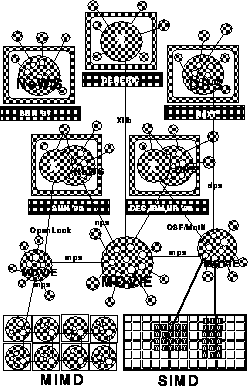




Next: 17.2.6 Object Orientation
Up: 17.2 System Overview
Previous: 17.2.4 Model for MIMD-parallelism
Distributed computing is the most natural environment for the MOVIE
System. The communication model for MOVIE networks is based on one
simple principle, uniform for distributed and MIMD-parallel
architectures: nodes of such network communicate by sending
MovieScript. This model unifies communication and computation:
Computing in MOVIE is when a server interprets MovieScript, whereas
communication occurs when a server sends MovieScript to be interpreted
by another server on the network.
Social human activities provide adequate analogies here. One can think
of MOVIE network as a society of autonomous intelligent agents, capable
of internal information processing and of information exchange, both
organized in terms of the same high-level language structures. The
processing capabilities of such a system are in principle unlimited.
Detailed programming paradigms for distributed computing are not
specified initially at the MovieScript level and can be freely selected
depending on the application needs. Successful computation/communication
patterns with some reusability potential can then be retained within
the system in the form of appropriate MovieScript extensions.
The MovieScript-based user-level model for MOVIE networks is uniform, elegant,
and appealing. Its detailed technical implementation, however, is a complex
task. Communication services must be included at the lowermost level of the
inner loop of the MovieScript interpreter and coordinated with scheduling,
event handling, software interrupts, and other dynamic components of the
server. Also, when building interfaces to existing Open Systems components,
we have to cope with various existing network and message-passing protocols.
In the networking domain, we use the UNIX socket library as the base-C-level
platform, but then the question arises of how to handle higher protocols
such as NFS, RPC, XDR and a variety of recent ``open'' models (see, e.g.
Figure 17.4). Similar uncertainties arise in handling and
integrating various message-passing protocols for MIMD-parallel computing.

Figure 17.4: An Example of the Distributed MOVIE Environment. The figure
illustrates various network-extensible graphics protocols used in
implementing the uniform high-level MovieScript protocol. We denote by
mps, nps, and dps, respectively, the MOVIE, NeWS, and
Display PostScript protocols. MOVIE servers communicate directly via
mps, whereas MovieScript messages sent to NeWS/DPS/X servers are
internally translated by the MOVIE server to the remote server-specific
protocols.
Since the consistent implementation of the MovieScript-based communication is
one of the most complex tasks in the MOVIE development process, we adopted
the following evolutionary and self-supporting approach. The system design
was started in the single-node, single-thread configuration. The notion of
multithreading was built into the design from the beginning by adopting
consistent thread-relative addressing modes. In consequence, the detailed
model for scheduling, networking, and message passing factorized as an
independent sector of MovieScript and it was initially postponed. The base
interpreter loop was developed first. In the next stage, we constructed the
field algebra for regular matrix processing, interpreted object-oriented
model with rapid prototyping capabilities and
graphics/visualization/windowing layers with the focus on interpreted GUI
interfaces.
These layers are currently in the mature stage and they can now be used to
provide GUI support for prototyping multithreading distributed MOVIE
networks, starting with the regular modules for concurrent matrix algebra and
signal processing. The current status of the design and implementation work
on scheduling, networking and message passing is described in
[Niemiec:92a], [Niemiec:92b] and [Furmanski:93a].





Next: 17.2.6 Object Orientation
Up: 17.2 System Overview
Previous: 17.2.4 Model for MIMD-parallelism
Guy Robinson
Wed Mar 1 10:19:35 EST 1995





